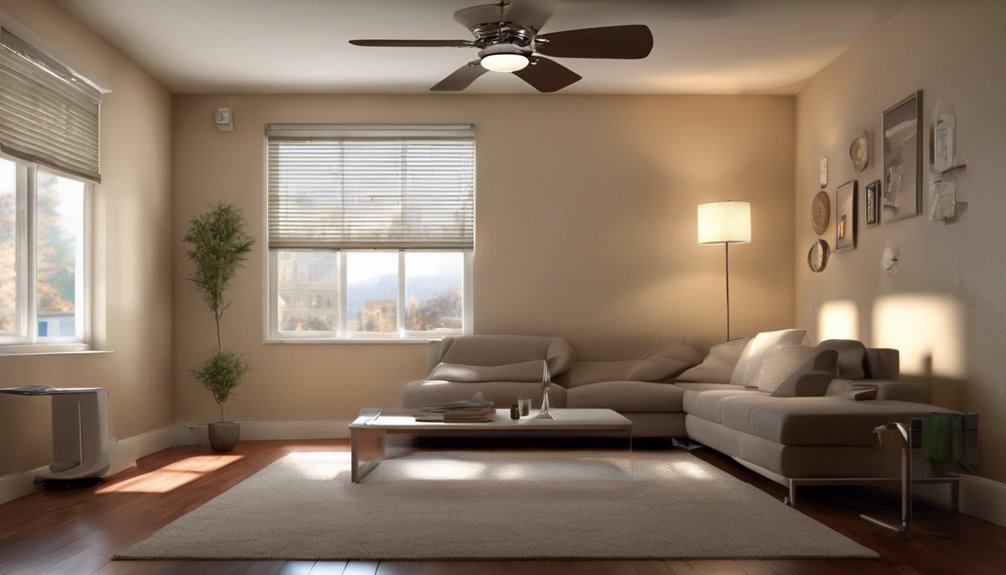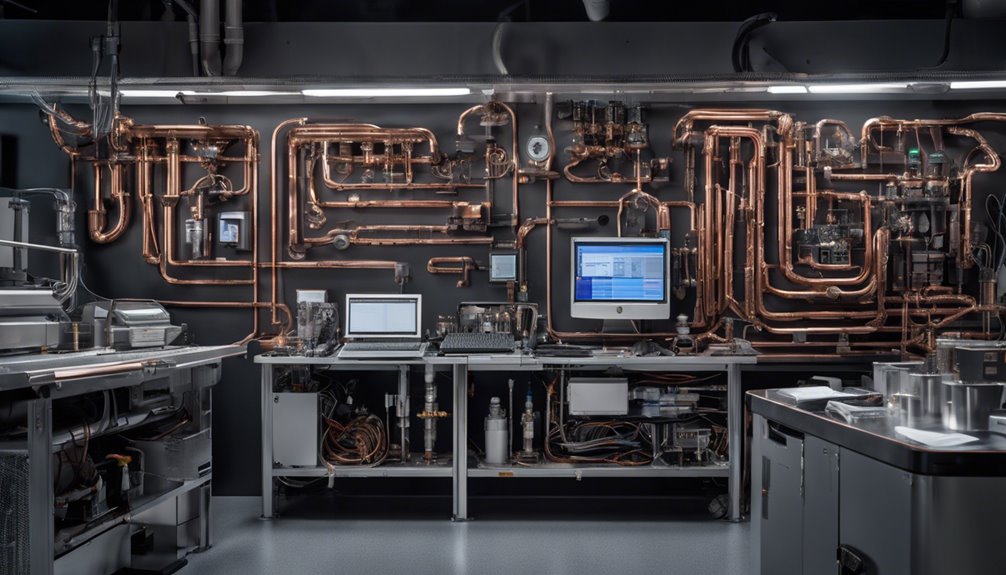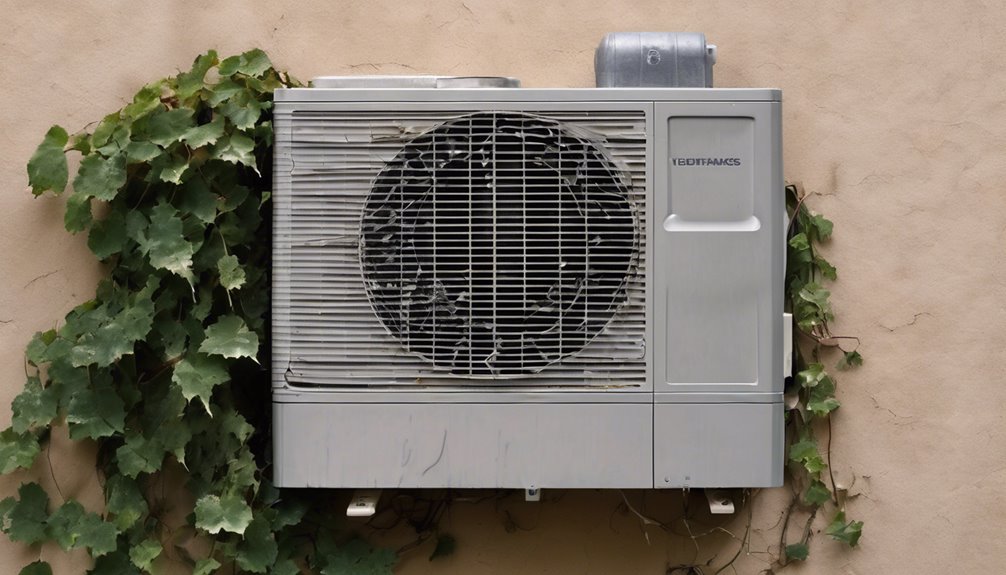To make your AC more energy efficient, start by upgrading to a high-efficiency unit and regularly cleaning or replacing your AC filter. Then, optimize your thermostat settings by creating a schedule and using smart temperature control. You can also supplement cooling with ceiling fans and natural methods like planting trees and using window treatments. By implementing these tips, you'll reduce your energy bills and environmental impact while staying cool and comfortable. Want to learn more ways to maximize your AC's energy efficiency?
Key Takeaways
- Upgrade to a high-efficiency AC unit with an ENERGY STAR certification to reduce energy bills and improve air flow.
- Regularly clean or replace the AC filter to prevent increased energy bills and reduced airflow.
- Install a smart thermostat with temperature sensors and scheduling features to maximize energy efficiency.
- Use natural cooling methods like ceiling fans, trees, and greenery to reduce the AC's workload and energy consumption.
- Seal air leaks and add insulation to prevent heat gain and reduce the AC's energy usage.
Upgrade to a High-Efficiency AC Unit
If you're still using an old, inefficient air conditioning unit, it's time to consider upgrading to a high-efficiency AC unit.
This won't only reduce your energy bills but also improve the air flow in your home. Look for units with high energy ratings, such as the ENERGY STAR certification, which indicates that the product meets energy efficiency standards set by the U.S. Environmental Protection Agency.
A high-efficiency AC unit will use advanced technology to cool your home more efficiently, reducing the strain on your wallet and the environment. By upgrading, you'll enjoy a cooler, more comfortable home while doing your part to reduce energy consumption.
Regularly Clean and Maintain Your AC Filter
You'll be surprised at how a dirty AC filter can increase your energy bills and reduce airflow.
If you don't clean or replace it regularly, it'll make your AC work harder, leading to higher electricity costs and a shorter lifespan.
Dirty Filter Consequences
A dirty air conditioner filter can wreak havoc on your energy bills and the overall performance of your AC unit.
When you neglect your filter, it becomes clogged with dirt, dust, and debris, forcing your AC to work harder and consume more energy. This not only increases your energy costs but also reduces the unit's lifespan.
Regular filter inspection is crucial to prevent these consequences. By inspecting your filter, you can identify any issues before they escalate.
Don't let filter neglect compromise your AC's efficiency. Stay on top of your filter's condition to ensure your AC runs smoothly and efficiently.
Filter Cleaning Schedule
Establishing a regular filter cleaning schedule is essential to maintaining your air conditioner's energy efficiency.
You should clean your filter every 1-3 months, depending on usage and air quality. A dirty filter reduces airflow, making your AC work harder and increasing energy bills.
Cleaning your filter regularly improves air quality and extends its lifespan. A clean filter also helps your AC run smoothly, reducing the risk of breakdowns and costly repairs.
Optimize Your Thermostat Settings
You can make a significant impact on your energy consumption by optimizing your thermostat settings.
Smart Temperature Control
Smart temperature control is key to maximizing your air conditioner's energy efficiency.
By installing temperature sensors in different zones of your home, you can create a zoning system that allows you to cool only the areas that need it. This way, you're not wasting energy on cooling empty rooms.
With smart temperature control, you can also set specific temperature ranges for each zone, ensuring that your AC is working at optimal levels. For example, you can set a higher temperature in your bedroom during the day when you're not using it, and a lower temperature in your living room where you spend most of your time.
This level of precision will help you save energy and reduce your utility bills.
Energy-Saving Schedules
With your zoning system in place, it's time to take your energy efficiency to the next level by optimizing your thermostat settings.
You can create an energy-saving schedule that aligns with your daily routine. Since energy peak hours usually occur during the day, consider raising your thermostat by a few degrees when you're not home or sleeping. This strategy can significantly reduce your cooling costs.
Analyze your cooling patterns to identify opportunities for adjustment. For instance, if you notice your AC kicks in frequently during the afternoon, try pre-cooling your home before the energy peak hours. By doing so, you'll reduce the load on your AC during the most expensive time of day.
Use Ceiling Fans to Supplement Cooling
Ceiling fans can be a cost-effective way to supplement your air conditioning, especially during mild summer days. By circulating air, they create a cooling effect, allowing you to raise your thermostat without feeling the difference. During the summer, run your ceiling fan in a counterclockwise direction to create a cooling breeze. This allows you to feel cooler, even when the temperature is higher.
| Fan Direction | Effect |
|---|---|
| Counterclockwise | Creates a cooling breeze, making you feel cooler |
| Clockwise | Recirculates warm air, making you feel warmer |
| Counterclockwise (high speed) | Creates a strong summer breeze, ideal for hot days |
| Counterclockwise (low speed) | Creates a gentle breeze, ideal for mild days |
Seal Air Leaks and Add Insulation
Air leaks and inadequate insulation can significantly reduce your air conditioner's efficiency, causing it to work harder and consume more energy.
To prevent this, you'll want to seal any air leaks around windows, doors, and ducts. Use caulk or spray foam to fill in gaps, and consider installing weatherstripping around moving parts.
Additionally, inspect your attic, walls, and floors for insulation gaps. Add insulation to these areas to prevent heat from entering your home.
Plant Trees and Greenery for Natural Cooling
You can harness the power of nature to cool your home by planting trees and greenery strategically around your property.
This natural approach to cooling can reduce your AC's workload and energy consumption. By creating shade through tree planting, you can block direct sunlight from heating up your home.
Urban forestry initiatives can also help mitigate the urban heat island effect, where built-up areas absorb and retain heat.
Strategically placed trees and greenery can reduce the temperature around your home by up to 9°F. This, in turn, can lead to significant energy savings.
Use Window Treatments to Block Out Heat
Window treatments are a simple yet effective way to block out heat and keep your home cool.
By using heat-blocking window treatments, you can significantly reduce the amount of heat that enters your home through your windows. Solar shades are a great option, as they can block up to 90% of the sun's heat and UV rays.
You can also use light-blocking curtains or blinds to keep the heat out. By keeping the heat out, you'll reduce the load on your AC, which means it'll use less energy to cool your home.
This can lead to significant savings on your energy bill. Plus, it'll help extend the life of your AC by reducing wear and tear.
Improve Air Circulation With Vents and Ducts
By optimizing your home's air circulation, you can make your AC work more efficiently and effectively.
Proper vent placement is key to achieving this. Ensure that vents aren't blocked by furniture or curtains, and consider relocating them to improve airflow.
Additionally, inspect your ducts for leaks, kinks, or damage, and consider a duct redesign if necessary. This can help reduce energy loss and improve overall system performance.
Consider a Smart Thermostat for Automation
A smart thermostat can be a game-changer for maximizing your AC's energy efficiency.
By installing one, you'll gain access to smart features that help you automate and optimize your cooling system. For instance, you can program your thermostat to learn your schedule and preferences, so it adjusts the temperature accordingly.
Automate and optimize your cooling system by programming your thermostat to learn your schedule and preferences.
This automation benefit ensures your AC isn't wasting energy when you're not home or sleeping. You'll also receive alerts and notifications to remind you to change filters or schedule maintenance, ensuring your system runs smoothly.
Plus, you can control your thermostat remotely, making it easy to adjust the temperature even when you're not at home. With a smart thermostat, you can save energy, reduce bills, and enjoy a more comfortable living space.
Frequently Asked Questions
Can I Use a Programmable Thermostat With an Older AC Unit?
You can likely use a programmable thermostat with your older AC unit, but you'll need to check its compatibility first. If it's not compatible, consider modernizing your AC system to take advantage of energy-saving features.
How Often Should I Replace My AC Unit's Refrigerant?
You shouldn't need to replace your AC unit's refrigerant often, but you should check for refrigerant leaks regularly. Proper filter maintenance also helps, as dirty filters can cause the system to work harder, wasting refrigerant and energy.
Will a Bigger AC Unit Always Provide Better Cooling?
You might think a bigger AC unit means better cooling, but that's not always the case. A larger unit can lead to airflow restrictions, reducing its cooling capacity, and actually making your space less comfortable.
Can I Install a Ceiling Fan in a Room With a Vaulted Ceiling?
You can install a ceiling fan in a room with a vaulted ceiling, but you'll need to consider vaulted installation requirements and strategic fan placement to ensure optimal airflow and energy efficiency.
Does a Smart Thermostat Work With a Heat Pump System?
You're wondering if a smart thermostat works with a heat pump system. The good news is that many smart thermostats are compatible with heat pumps, offering Heat Pump Integration and Smart Thermostat Compatibility for seamless temperature control.
Conclusion
You've made it to the final step in making your AC more energy efficient! By implementing these simple yet effective tips, you'll be saving energy and reducing your utility bills in no time. Remember, every small change adds up, from upgrading to a high-efficiency AC unit to optimizing your thermostat settings. With these changes, you'll be staying cool while keeping the planet cool too!



